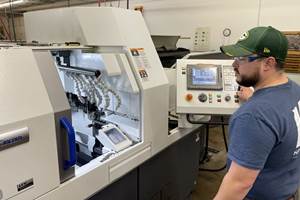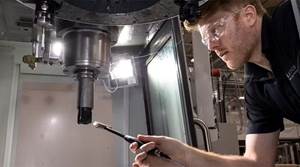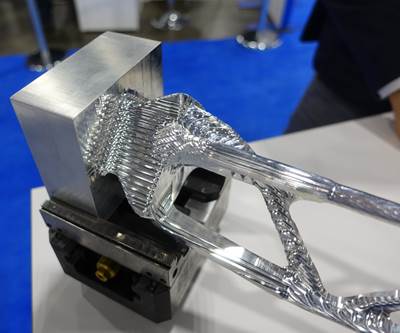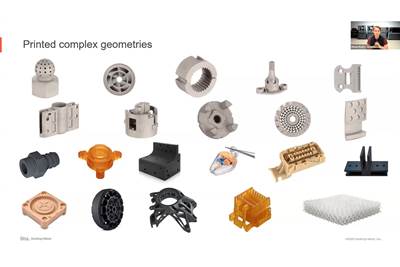Generative Design for Milling Lightweights EV Motorbike Part
Autodesk’s Fusion 360 generative design function can create mass-saving solutions for three-axis milling and other conventional manufacturing processes.
Share






The three-piece milled swing arm Autodesk created through generative design saves 8% of mass compared to the original die-cast part. Lightning Motors says the revised swing arm should increase the performance capabilities and rider feel of its LS-218 motorcycle on account of the part’s reduced weight and enhanced directional stiffness. All images courtesy of Autodesk.
Generative design is an efficient way to remove mass from a part design, but manufacturing the generated part can still be expensive, particularly for metal parts. , a California-based manufacturer of electric motorcycles, knows this especially well.
In 2018, Lightning partnered with Autodesk to lightweight a production motorcycle swing arm through generative design. The resulting plan created a magnesium alloy part that was 38% lighter, but which required Lightning to use investment casting and increased costs beyond commercial feasibility.
In 2021, the companies repeated the generative process with an updated solver in Autodesk’s Fusion 360 CAD software. This new solver supports a wider variety of manufacturing methods, including three-axis milling. Specifying milling as the final production method resulted in a three-part prototype build that met performance needs while saving 8% of mass at a much smaller price increase. The new generated part also helps maintain supply chain continuity by using the same 6,000-series aluminum as the original die cast part.
What Is Generative Design?
Generative design software uses a set of user-input parameters and constraints to develop efficient part designs. These shapes are often organic forms no human would design on their own, and in its earliest years generative design was locked to additive manufacturing and production methods facilitated by additive manufacturing. Not long after Lightning and Autodesk developed their first iteration of the generatively designed motorcycle swing arm, Autodesk updated its solver to support milling and other conventional manufacturing methods. Design candidates generated for milling generally cannot reach the same level of optimization as their AM siblings, but they are much easier to manufacture while still reducing the weight of the part.
The generative design system produces a wide variety of potential solutions, even within a traditional manufacturing method like three-axis milling, so it also includes a filtering system to focus on top-performing solutions for the user’s performance criteria. Users can manually adjust designs in a manner Simpson describes as like sculpting clay: dragging a point out of the design moves the surrounding area to merge it into a smooth shape.
Problems and Parameters
Autodesk Fusion 360 technical consultant (and designer for the project) Peter Simpson says the generative design process begins with defining the “problem.” Part of this definition involves choosing the final production method. The software also asks users to set several method-specific parameters to further narrow down results: one example for three-axis milling would be the user’s minimum tool diameter.
After setting the production method and parameters, Simpson imported Lightning’s CAD file of the original, die-cast part into Fusion while Autodesk principal research engineer Nick Markovic examined Lightning’s finite element analysis (FEA) report for the part. Both the CAD file and the FEA report focused on the full assembly rather than the individual parts, so Simpson and Markovic separated these out — but not before Simpson used the full model to highlight pieces of present geometry, such as interfaces and bolt holes, that future designs needed to keep, as well as obstacles like motorcycle wheel these designs needed to avoid. Fusion 360’s shared, cloud-based file system enabled the pair to conduct their work simultaneously without causing errors.
While the 2021 milled part (top) does not reduce the original part’s weight to the same extent as the 2018 investment cast version (bottom), the newer part has proved less expensive and outperforms the 2018 version in structural and load requirements. Click to expand the image.
Narrowing the Possibilities
The generative design system produces a wide variety of potential solutions, even within a traditional manufacturing method like three-axis milling, so it also includes a filtering system to focus on top-performing solutions for the user’s performance criteria. Users can manually adjust designs in a manner Simpson describes as like sculpting clay: dragging a point out of the design moves the surrounding area to merge it into a smooth shape. Simpson also says users can leverage accessibility check or minimum feature analysis functions to see which adjusted features would be incompatible with the chosen manufacturing method, but this check is not automatic.
After narrowing the field of design candidates, Markovic used a separate workspace within Fusion 360 to perform stress and load simulations. According to from Simpson, Markovic and Lightning Motorcycles president Richard Hatfield, these stress analyses of load cases examined the part’s maximum deflections and surface stress to determine its “Factor of Safety,” or whether the stresses were above the material’ strength limits. The 2018 design failed to meet today’s Factory of Safety requirements, but Markovic and Simpson were able to tailor their 2021 three-axis design candidates until one passed this test.
Proving-Out
After finding a prototype design that met Lightning’s requirements, Simpson and Markovic began proving it out at Autodesk’s Birmingham Technology Center. Their feasibility studies focused on determining what kinds of jigs and fixtures Lightning would need to produce these parts through CNC milling.
At the conclusion of the feasibility studies, Autodesk will hand off the prototype to Lightning Motorcycles to enable Lightning to make tweaks for commercial production viability.
Related Content
How this Job Shop Grew Capacity Without Expanding Footprint
This shop relies on digital solutions to grow their manufacturing business. With this approach, W.A. Pfeiffer has achieved seamless end-to-end connectivity, shorter lead times and increased throughput.
Read MoreContinuous Improvement and New Functionality Are the Name of the Game
Mastercam 2025 incorporates big advancements and small — all based on customer feedback and the company’s commitment to keeping its signature product best in class.
Read MoreERP Provides Smooth Pathway to Data Security
With the CMMC data security standards looming, machine shops serving the defense industry can turn to ERP to keep business moving.
Read MoreHow to Mitigate Chatter to Boost Machining Rates
There are usually better solutions to chatter than just reducing the feed rate. Through vibration analysis, the chatter problem can be solved, enabling much higher metal removal rates, better quality and longer tool life.
Read MoreRead Next
Generative Design Generates New Interest in a Range of Manufacturing Options
New developments in generative design can help companies make better decisions about part design by including manufacturability as a key value. CNC milling, for example, not an additive process, might come up as the better choice for making a complex part.
Read More3D Printing, Generative Design Put This EV on a "Diet"
Redesigning and consolidating the components of Arcimoto's Fun Utility Vehicle (FUV) will bring this small electric car into the realm of micromobility. More in a recent episode of The Cool Parts Show.
Read MoreMethods and Benefits of Designing for Additive Manufacturing
Additive manufacturing may have different process considerations than traditional manufacturing, but it can manage these through clever planning and specialized software.
Read More





















